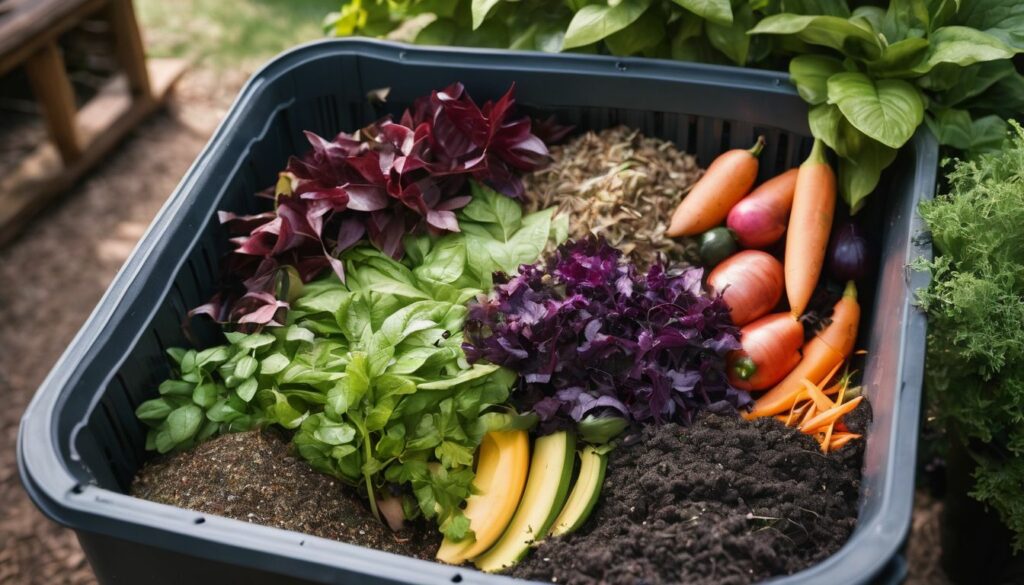As winter begins to hint at its frosty arrival, you might find yourself pondering – do I need to tuck my garden in with a cozy cover? It’s something many of us green-thumbed enthusiasts wrestle with; after all, we dream of our gardens bursting back into vibrant life come spring.
But did you know that the right winter prep could influence whether your garden wakes up boasting plentiful blossoms or shows sparse signs of survival? In this handy guide, we’ll explore why it’s so crucial to give your garden that extra bit of TLC as temperatures plummet and offer practical steps to shield it efficiently from icy frosts.
So are you ready to keep those green thumbs nimble during the chilly months ahead? Let’s get our hands dirty!
Key Takeaways
- Winter garden protection is important to keep your plants safe from frost and cold temperatures.
- Using covers like burlap or frost cloth can help protect your plants and keep pests away.
- Harvesting and storing vegetables properly before the first frost ensures that you can enjoy them throughout the winter months.
- Covering garden beds with black plastic, cardboard, or mulch helps retain heat and moisture, preventing damage from freezing temperatures.
- Trimming herbs back, transferring them to pots with well-draining soil, and bringing them indoors can help them survive the winter.
- Preparing berry patches by cutting back dead canes, removing weeds, and applying organic mulch protects them from freezing temperatures.
- Cleaning up dead foliage around perennials, watering before the ground freezes, and adding mulch around their base helps protect their roots during winter.
- Winterizing roses involves pruning dead branches, adding mulch around the base of the plant for insulation, and covering bushes with burlap or frost cloth for extra protection.
Why Winter Garden Protection is Important
Cold can harm your plants. Winter garden protection is a must to keep them safe. It stops the frost from hurting your plants’ roots and leaves. This is why I use covers like burlap or frost cloth in my winter garden care.
Using these covers also keeps pests away from the plants. When it gets cold, bugs might try to live in your warm garden beds! But when they’re covered, there’s no room for these pests.
Also, you might want to grow some veggies through the winter months. A good winter cover lets this happen by keeping things warm inside. So not only do we protect our gardens with these methods, but we even get fresh food out of it!
Mulch is another great way to help. We put a layer of mulch around our trees and shrubs before it gets too cold. The organic matter helps lock in heat and protects against freezing temperatures.
Finally, have you ever thought about what wind can do? Just like the frost, winds can be very hard on your delicate flowers and greens during those chilly months! Our fences take care of that problem – they act as windbreaks guarding against gusty blows!
Steps for Preparing Your Garden for Winter:
To prepare your garden for winter, start by harvesting and storing vegetables.
Harvest and Store Vegetables
To prepare your garden for winter, it’s important to harvest and store vegetables properly. This ensures that you can enjoy the fruits of your labor even during the colder months. When harvesting vegetables, make sure to do it before the first frost hits.
Choose mature and healthy vegetables, as they have a better chance of storing well. Remove any damaged or diseased parts before storing them. For root crops like carrots and potatoes, dig them up carefully to avoid bruising.
Once harvested, clean off any excess dirt or debris and let them dry naturally. Place them in cool storage areas like basements or root cellars where temperatures are between 32-40°F (0-4°C) with high humidity levels.
Prepare Herbs for Winter
To prepare my herbs for winter, I first trim them back to remove any dead or diseased foliage. I then gently dig up the root ball and transfer it to a pot with well-draining soil. This way, I can bring the potted herbs indoors where they’ll be protected from freezing temperatures.
Before bringing them inside, I give them a good watering and place them in a location that receives plenty of sunlight. Throughout the winter, I make sure to water them regularly and keep an eye out for any signs of pests or disease.
By taking these steps, I can ensure that my herbs survive the harsh winter months and thrive when spring arrives again.
Cover Garden Beds
To protect your garden beds during the winter, it is important to cover them properly. One option is to use black plastic or a layer of cardboard as a barrier between the soil and the cold weather.
This helps retain heat and moisture in the soil, preventing it from freezing. Another option is to use old carpet or mulch as a protective layer over your garden beds. This insulation can keep the plants and their root systems warm during winter.
By covering your garden beds, you can prevent frost damage and ensure that your plants survive the cold temperatures.
Prepare Berry Patches
To prepare berry patches for the winter, it is important to start by cutting back any dead or diseased canes. Remove weeds and debris from the area around the plants. Apply a layer of organic mulch, such as straw or leaves, around the base of the plants to provide insulation and protect them from freezing temperatures.
This will help retain moisture in the soil and prevent it from drying out during colder months. Prune any remaining healthy canes according to specific plant requirements. By taking these steps, you can ensure that your berry bushes are well-protected and ready to flourish when spring arrives.
Prepare Perennials
To prepare perennials for winter, there are a few important steps to take. First, make sure to clean up any dead foliage or plants from around the base of your perennials. This helps prevent pests and diseases from overwintering in your garden.
Next, give your perennials a good watering before the ground freezes. This will help them stay hydrated during the winter months. Finally, add a layer of mulch around the base of each plant to provide insulation and protect their roots from freezing temperatures.
Using organic mulch like wood chips or straw is best for this job.
Winterize Roses
To winterize roses, start by pruning them in late fall to remove any dead or damaged branches. Next, protect the base of the plant by building up a layer of mulch around it. This will insulate the roots and help prevent frost damage.
You can also cover your rose bushes with burlap or frost cloth to provide extra protection from freezing temperatures and harsh winds. Remember to water your roses thoroughly before winter sets in, as hydrated plants are better equipped to withstand cold weather.
By taking these steps, you can ensure that your roses stay healthy and come back strong in the spring.
Prepare Trees and Shrubs
To prepare trees and shrubs for winter, I start by giving them a good watering before the ground freezes. This helps to hydrate their roots and protect them from drying out during the cold months.
Next, I apply a layer of mulch around the base of each tree and shrub. This acts as insulation, keeping the soil temperature more stable and protecting the roots from extreme cold.
Lastly, I prune any dead or damaged branches to prevent them from breaking under heavy snow loads. By taking these steps, I can ensure that my trees and shrubs stay healthy throughout the winter season.
Turn Off Watering System
Before winter arrives, it’s important to turn off your watering system. This will prevent any water from freezing and causing damage to the pipes and sprinklers. Freezing water can lead to cracks or burst pipes, which can be expensive to repair.
By shutting off the watering system and draining any remaining water, you can avoid these issues and ensure that your system is in good shape for when you need it again in the spring.
So before temperatures drop too low, take a moment to turn off your watering system and protect it from winter damage.
General Garden Maintenance
I take care of my garden all year round, even during the winter months. General garden maintenance is important to keep it healthy and ready for the next growing season. In winter, I make sure to clean up any fallen leaves or debris that could harbor pests or diseases.
I also prune back any dead branches or overgrown plants to promote new growth in spring. It’s essential to remove any weeds that may be still hanging around as they can compete with your plants for nutrients come springtime.
By keeping an eye on my garden and providing regular upkeep, I ensure a healthy environment for my plants even during the colder months.
Ways to Protect Your Garden:
There are several effective ways to protect your garden in the winter. Read on to learn more about these methods and ensure your plants stay healthy and thriving throughout the colder months.
Covering with Mulch
I like to cover my garden with mulch during winter because it helps protect the soil and plants from freezing temperatures. Mulch acts as a blanket, keeping the soil warm and preventing it from drying out.
I use organic mulch, such as straw or shredded leaves, and spread a thick layer over my garden beds. This not only insulates the roots of my plants but also suppresses weed growth and retains moisture in the soil.
Mulching is an easy and effective way to provide extra protection to your garden during the winter season.
Using Row Covers
Row covers are a great way to protect your garden during the winter months. These covers are made from lightweight fabric and can be placed directly over your plants. They act as a barrier, keeping cold air and frost away from your crops.
Row covers also provide some insulation, trapping heat from the soil to keep your plants warm. They are easy to use and can be secured with stakes or clips. By using row covers, you can extend the growing season for cool-season crops and protect delicate plants from freezing temperatures.
It’s a simple yet effective method of winter garden protection that every gardener should consider.
Building Cold Frames
To protect your winter garden, building cold frames can be a great option. Cold frames are simple structures with a clear top that allows sunlight to enter and warm the plants inside.
They act like mini greenhouses, providing insulation and shelter from harsh weather conditions. To build a cold frame, you can use materials such as wooden boards or cinder blocks to create the walls, and then cover it with a transparent material like plastic or glass for the top.
Make sure to position the cold frame where it will receive maximum sunlight during the day. This will help keep your plants warmer and protected from frost and freezing temperatures.
Cold frames are especially useful for growing cool-season crops during winter, extending your growing season significantly. They also provide a controlled environment for starting seeds early in spring before transplanting them into your garden beds.
Installing Hoop Houses
I love using hoop houses to protect my garden during the winter. Hoop houses are simple structures made with flexible arches, usually made of metal or PVC pipe, that are covered with greenhouse plastic or row cover fabric.
They create a mini-greenhouse effect by trapping heat and protecting plants from frost and freezing temperatures. Hoop houses are easy to install, affordable, and can be customized to fit any garden size.
They provide excellent insulation and can extend the growing season by several weeks or even months. I highly recommend installing hoop houses in your garden for effective winter protection.
Utilizing Cloches
Cloches are a great way to protect your plants during the winter. These bell-shaped covers trap heat and create a mini-greenhouse effect, keeping your plants warm and safe from frost.
Simply place the cloche over individual plants or rows of seedlings, making sure it is secure in the ground. The transparent material allows sunlight to enter while shielding against cold winds.
Cloches can be made from plastic or glass and come in different sizes to accommodate various plant heights. They are easy to move around as needed and provide instant protection for your garden during the colder months.
Providing Shade
During the winter, providing shade to your garden can help protect delicate plants from harsh sunlight and freezing temperatures. This can be done by using materials like old bedsheets, burlap, or frost cloth to cover plants during particularly sunny days or when there’s a risk of frost.
By creating shade, you can prevent sunscald on evergreen foliage and minimize fluctuations in soil temperature, reducing stress on your plants. Additionally, shading can also help retain moisture in the soil and prevent it from drying out too quickly during colder months.
Remember to securely anchor the shade material so that it doesn’t blow away in strong winds.
Common Mistakes to Avoid When Winterizing Your Garden
Neglecting to cover plants with protective materials is one common mistake that can leave your garden vulnerable to freezing temperatures and frost damage.
Overlooking Soil Health
Taking care of the soil health in your winter garden is often overlooked, but it’s crucial for the long-term success of your plants. Healthy soil provides nutrients and moisture that plants need to survive during the cold season.
To ensure soil health, add organic matter like compost or well-rotted manure to enrich the soil. You can also cover bare soil with a layer of mulch or leaves to protect it from erosion and maintain its moisture levels.
Additionally, consider planting cover crops like legumes or grasses to improve soil structure and fertility. By prioritizing soil health in your winter garden preparations, you’ll set a solid foundation for thriving plants come springtime.
Neglecting to Cover Plants
Not covering your plants during the winter can lead to frost damage and plant death. When exposed to freezing temperatures, plants can suffer from dehydration and cell damage. Additionally, without protection, delicate flowers and buds may freeze and die off.
Remember that even hardy plants can be vulnerable to extreme cold if not adequately insulated. It’s important to cover your plants with materials like burlap or blankets to provide a protective barrier against harsh winter conditions.
By neglecting to cover your plants, you risk losing them altogether due to the damaging effects of frost and freezing temperatures.
Failing to Clean Up Garden Beds
I made a mistake last winter when I didn’t clean up my garden beds properly. This is an important step in preparing your garden for the cold season. Failing to clean up your garden beds can lead to the growth of pests and diseases, as well as weed overgrowth.
It’s essential to remove any dead plants, fallen leaves, and weeds from the bed before winter arrives. By doing this, you can prevent pests from using your garden as their winter home and ensure that your plants have a healthy start when spring comes around again.
So don’t forget to clean up those garden beds!
Not Taking Notes
I understand that taking notes may not seem like the most exciting part of winter garden preparation, but it’s actually quite helpful. When we’re busy working in the garden and making all these preparations, it can be easy to forget some important details.
By taking notes throughout the process, we can keep track of what works well and what doesn’t. These notes will serve as a valuable reference for future winters when we need to protect our garden again.
So let’s make an effort to jot down any observations or insights during this time – it will save us from repeating mistakes and help us improve our winter garden protection in the long run!
Conclusion
In conclusion, it is important to protect your garden during the winter months. By covering your garden beds and using protective methods like mulch, row covers, and hoop houses, you can prevent frost damage and keep your plants healthy.
Don’t forget to take notes and learn from any mistakes made this winter for better garden protection next year. Stay proactive and give your garden the care it needs even in colder temperatures!
FAQs
1. Should I cover my garden in the winter?
Yes, covering your garden in the winter with tarp or blanket protection helps keep plants safe from cold weather and frost.
2. What are some winter garden protection methods?
Winter plant care involves insulating gardens, using a garden cover for frost protection for plants, and regular maintenance.
3. How can I prepare my garden for winter?
Preparing your garden for winter includes performing soil management tasks, protecting it with proper cover options, and applying recommended strategies to protect plants.
4. Are there special tips for gardening in cold weather?
Cold weather gardening needs extra attention like wrapping a protective layer around delicate plants to save them from freezing temperatures.
5. Why is it important to winterize the garden?
Winterizing the garden is essential as it aids in preserving plant health over cold months ensuring that they stay robust and healthy till spring arrives again.





